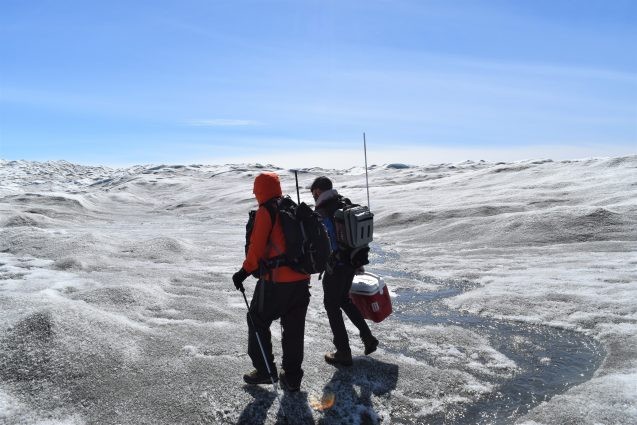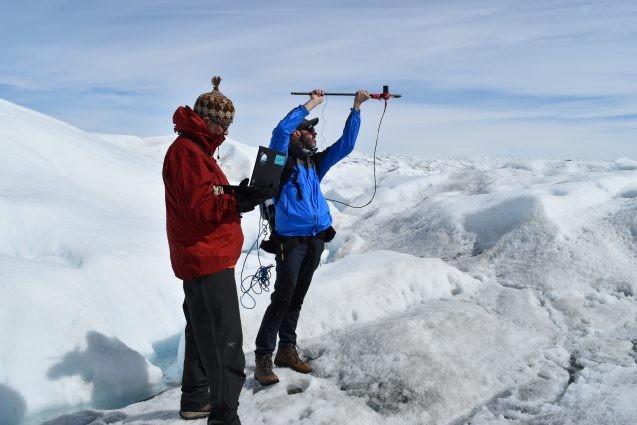Scientists Harness Satellites to Track Algae Growth on Greenland Ice Sheet
To measure algal blooms across large regions of the Greenland ice, and understand their effects on melting over time, scientists are turning to space.
Scientists know that the brownish-grey algae that darken the Greenland ice sheet in summer cause the ice to melt faster, but only recently have they measured these blooms in the field, and only at few sites. To measure algal blooms across large regions and understand their effects on melting over time, they are now turning to space.
“Scientists go into the field and sample one or two spots where these blooms occur, but we don’t really know how they change over time or over a large region,” said Shujie Wang, lead author of a recent study showing that satellites can be used to track the growth of ice algae over wide areas.
To measure algae growth, Wang and her colleagues borrowed long-standing methodology used by other scientists to measure algae in the oceans, using satellite observations of water color. Marine algae differ from those on ice, but both kinds contain chlorophyll-a, which has a distinct reflected near-infrared radiation signature that satellite sensors can detect.
Mapping glacier algae over space and time can give researchers insights into how algae affect the reflectivity, or albedo, of the ice surface, said Wang, who conducted the research as a postdoctoral scholar at Columbia University’s Lamont-Doherty Earth Observatory. She is now an assistant professor of geography at Penn State University.

“Albedo is crucial for understanding how ice melts and what will happen in the future to the contribution of Greenland to sea level rise,” said Lamont-Doherty research professor Marco Tedesco, who supervised Wang’s work. “Little is known of the effects of algae on this, and the work by Shujie is pioneering in this regard.”
Light-colored snow and ice have a high albedo, meaning that they reflect most incoming solar radiation back to the atmosphere. But when algae accumulate, they darken the surface; this causes it to absorb more radiation, warming the ice and accelerating surface melt.
The researchers used data from the Medium Resolution Imaging Spectrometer (MERIS) on the European Space Agency’s Envisat satellite to quantify algal blooms in southwestern Greenland from 2004 to 2011. They compared the data to measurements taken in the field and by NASA’s Moderate Resolution Imaging Spectrometer (MODIS), which measures surface albedo.
They found that chlorophyll-a signatures captured by MERIS matched field data, confirming that researchers can use ocean-color satellite data to measure algal growth and see how it changes over the summer. The same held true for the albedo changes measured by MODIS.
“We came up with a rough estimate that if algae growth doubles, then albedo decreases between 2 percent to 4 percent,” said Wang. “This biological component has never before been incorporated into climate modeling.”

The researchers also found that years with fewer cloudy days, and therefore more solar radiation, saw more algae development. “Algae need solar radiation to create energy through photosynthesis, so shortwave radiation may be an important factor controlling how much algae will grow or how they’re spatially distributed,” Wang said.
The interplay among climate, algae and ice creates a cycle that can accelerate the melting process. As Greenland warms, higher temperatures are directly causing more ice to melt. But the warming also appears to be changing atmospheric circulation patterns, and recently there has been a trend toward more sunny days. More sunny days means the ice will absorb more solar radiation and melt faster. The solar radiation also promotes algae growth, further accelerating melt.
In addition to improving regional climate models, the research has implications for the exploration of other planets. “Algae and bacteria are the only life on the ice sheet, and it is fascinating to imagine that the areas where they thrive are among the closest thing we can imagine to extraterrestrial life,” said Tedesco, who also holds a position at the NASA Goddard Institute for Space Studies.
The next step is to quantify how much algae development increases the production of melt water. Wang plans to address that question in subsequent research.
Also participating in the research were Patrick Alexander of Lamont-Doherty and Goddard Institute for Space Studies; Min Xu of the University of South Florida; and Xavier Fettweis of the University of Liege, Belgium. The research was supported by the U.S. National Science Foundation, NASA and the Heising-Simons Foundation.
Adapted from a press release by Penn State University.
